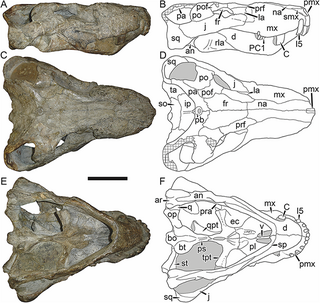| Delphaciognathus | |
|---|---|
| Scientific classification | |
| Domain: | Eukaryota |
| Kingdom: | Animalia |
| Phylum: | Chordata |
| Clade: | Synapsida |
| Genus: | † Delphaciognathus Broom, 1932 |
Delphaciognathus is an extinct genus of non-mammalian synapsids.
| Delphaciognathus | |
|---|---|
| Scientific classification | |
| Domain: | Eukaryota |
| Kingdom: | Animalia |
| Phylum: | Chordata |
| Clade: | Synapsida |
| Genus: | † Delphaciognathus Broom, 1932 |
Delphaciognathus is an extinct genus of non-mammalian synapsids.

Synapsida is a diverse group of tetrapod vertebrates that includes all mammals and their extinct relatives. It is one of the two major clades of the group Amniota, the other being the more diverse group Sauropsida. Unlike other amniotes, synapsids have a single temporal fenestra, an opening low in the skull roof behind each eye socket, leaving a bony arch beneath each; this accounts for the name "synapsid". The distinctive temporal fenestra developed about 318 million years ago during the Late Carboniferous period, when synapsids and sauropsids diverged, but was subsequently merged with the orbit in early mammals.

Therapsida is a clade comprising a major group of eupelycosaurian synapsids that includes mammals and their ancestors and close relatives. Many of the traits today seen as unique to mammals had their origin within early therapsids, including limbs that were oriented more underneath the body, resulting in a more "standing" quadrupedal posture, as opposed to the lower sprawling posture of many reptiles and amphibians.
Calleonasus is an extinct genus of non-mammalian synapsid from the Anisian Donguz Formation of Russia.
Driveria is an extinct genus of non-mammalian synapsids the Lower Permian of San Angelo Formation, Texas. It is mostly known from several postcranial bones, including the scapula, pelvis, and a few vertebrae and ribs, although a fragment of the skull that might pertain to the upper temporal fenestra is also associated with this species.
Elatosaurus is an extinct genus of non-mammalian synapsid.
Emydorhinus is an extinct genus of non-mammalian synapsid.
Ictidostoma is an extinct genus of non-mammalian synapsids known from the Tropidostoma Assemblage Zone.
Lanthanostegus is an extinct genus of non-mammalian synapsids from the Capitanian Tapinocephalus Assemblage Zone, Koonap Formation of South Africa. The type and the only species is Lanthanostegus mohoii.
Mastersonia is an extinct genus of non-mammalian therapsids from the Lower Permian of San Angelo Formation, Texas. It is only known from a few, very large vertebrae.

Milosaurus is an extinct genus of non-mammalian synapsids native to Illinois that was alive during the latest Carboniferous and earliest Permian. It was named in 1970 on the basis of FMNH 701, a partial skeleton, as well as referred material.
Orthopus is an extinct genus of non-mammalian synapsids. It is based on a partial humerus that closely resembles Estemmenosuchus, in the limited comparisons possible.
Nitosaurus is an extinct genus of non-mammalian synapsids.
Palemydops is an extinct genus of non-mammalian synapsid.
Scalopolacerta is an extinct genus of non-mammalian synapsids.
Trichasaurus is an extinct genus of caseid synapsids.

Stereophallodon is an extinct genus of non-mammalian synapsids.

Xyrospondylus is an extinct genus of non-mammalian synapsids belonging to the Edaphosauridae. The type species, X. ecordi, was named in 1982; it was originally named as a species of Edaphosaurus in 1957.

Watongia is an extinct genus of non-mammalian synapsids from Middle Permian of Oklahoma. Only one species has been described, Watongia meieri, from the Chickasha Formation. It was assigned to family Gorgonopsidae by Olson and to Eotitanosuchia by Carroll. Reisz and collaborators assigned the genus in Varanopidae. Based on comparisons of its vertebrae with other varanopids, it was the largest varanopid with a body length of approximately 2 metres. It was a contemporary of its closest relative, the much smaller Varanodon; the two may possibly represent growth stages of a single animal.

Leontosaurus is an extinct genus of non-mammalian synapsids from the Dicynodon Assemblage Zone, Balfour Formation of South Africa. It contains the single species L. vanderhorsti.

Shashajaia is a genus of extinct non-mammalian synapsids from the late Carboniferous to Early Permian. It was one of the earliest members of the group, coming from the Gzhelian stage. It lived in what is now the Halgaito Formation within the larger Cutler group located in the U.S state of Utah. According to a description study, this synapsid is known from well preserved dentary and jaw fragments. Shashajaia shares many similarities to other sphenacodontids including, enlarged (canine-like) anterior dentary teeth, a dorsoventrally deep symphysis and low-crowned, subthecodont postcanines having festooned plicidentine. The study also found that this genus is close to the evolutionary divergence of the Sphenacodontids and the Therapsids, from which mammalian synapsids arose from. Based on studies done on its teeth, Paleontologists found that as their prey became more terrestrial, synapsids like Shashajaia adapted to life on land and grew larger teeth to deal with larger herbivores in an evolutionary arms race.